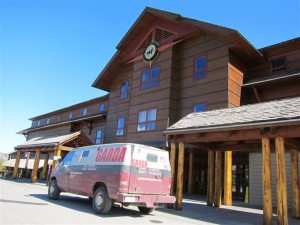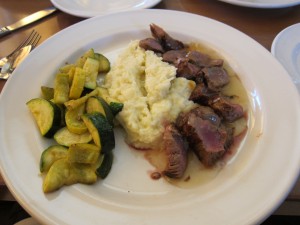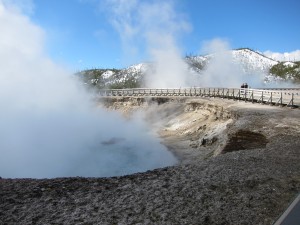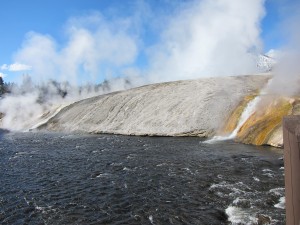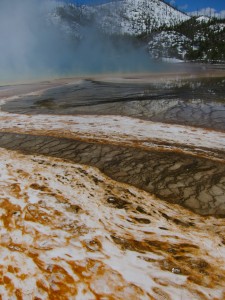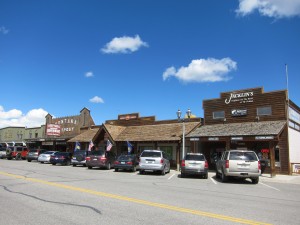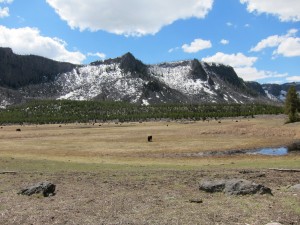As we mentioned in our last post a few days ago, we are finally going to finish the Passage Across America series about our trip across the USA and back. The last post we put up in the thread covered Keystone, South Dakota to Yellowstone National Park (which is located mostly in Wyoming, with a little bit in Montana and Idaho, as well). Since that post only contained pictures, in this post, we’ll fill in some of the story.
Knowing reservations to stay in the lodges in Yellowstone needed to be made at least a year in advance, we had brought camping gear and planned to camp inside the park. However, on May 11th and 12th, it snowed. We had no idea that in the northern latitudes snow still fell so late in the year. We just assumed it would be warm and balmy; none of our camping gear was meant for super cold weather.
Not wanting to freeze to death, on the morning of the 13th, we desperately tried to find a hotel room in or around the park. We called Yellowstone’s switch board, who thought we were trying to make reservations for next year. When we clarified we meant that very night, they didn’t know what to do! They didn’t normally deal with last minute callers. After checking with a manager, we were told they had one and only one room available. We had lucked out! Knowing we had a place to stay, we proceeded to Yellowstone, as planned.
Yellowstone sits on top of one of the largest active volcanoes on earth. It last erupted 640,000 years ago, and the force of the eruption made the volcano collapse into a 45 mile by 35 mile steaming caldera (crater), one of the largest in the world. A hot spot of magma still remains under the park, creating unique hydrothermal features. Due to its unique landscape, Yellowstone became the world’s first national park in 1872.
We spent the night at the Old Faithful Snow Lodge, an upscale hotel.
We had a phenomenal dinner at the hotel, with a main of Wild Boar Tenderloin brined with molasses and served with an apple ginger glaze. The sides are buttermilk mashed potatoes and seasonal vegetables. No, the wild boar served were not trapped in the park. The boar are actually farm raised outside the park. Farm raised wild boar is supposedly healthier and more environmentally friendly than farm raised cattle.
Continuing on where we left off… Friday, May 14, 2010 — Day 21: Yellowstone National Park, Wyoming to Jackson Hole, Wyoming.
While reading the Yellowstone Today newspaper at breakfast, we were interested to see that in January and February alone this year there were over 1800 small earthquakes here in Yellowstone, most less than 3 on the Richter scale. Normal activity is 2,000 earthquakes a year, most small. While the swarm of quakes is well above normal activity level, it isn’t unprecedented, so geologists aren’t concerned. Interestingly enough, it is these small earthquakes that keep sediment from settling so that the various hydrothermal sites stay active.
Inside the park there is no wifi connection. Eric had urgent business he needed to take care of, so after breakfast we hopped in the car to drive northwest to the nearest town, West Yellowstone, Montana, to find an Internet connection. On the way, we stopped at the Midway Geyser Basin walking trail, which is a half-mile walkway with three unique thermal attractions along the way:
1. Excelsior Geyser Crater was once the world’s biggest active geyser. Geysers are hot springs with constrictions in their plumbing that prevents hot water from bubbling up. While cool water sits on top, the water deep in the pool gets heated, creating steam that builds pressure. The pressure eventually builds up enough to force the water and steam past the constriction and up into the air.
Excelsior Geyser used to regularly erupt, with bursts between 50 and 300 feet high. In 1890, the geyser’s force blew itself out, transforming it from a geyser into a crater. The water is 200 degrees Fahrenheit, so it gives off a lot of steam. Since it was a cold day, we couldn’t see much of the crater through the vast amounts of steam.
Since the blowout happened, there have been a few eruptions with water shooting upward, but for the most part, it is now a thermal spring where the water simply flows over the edges of the crater and into the nearby Firehole River at a rate of 4,000 gallons per minute.
2. Grand Prismatic Spring is the third largest hot spring in the world at 200 feet wide. 500 gallons per minute of hot water (between 147 – 188 degrees Fahrenheit) bubble up from fissures in the rocks and run off into the nearby Firehole River. What makes this hot spring so special are the brilliant colors. The center of the spring is an intense blue. The outer edges of the pool and runoff channels have colorful microbes living in them, creating vivid yellow, orange and brown colors around the ring of blue. Once again, the cold day made the hot steam all the more intense, obscuring the view of the spring. The first shot is a runoff channel and you can kind of see the blue pool in the background through the steam. In the second shot, you can see the intense yellow ring surrounding the pool, and if you look carefully, can sort of see the pool to the back left.
3. The Turquoise Pool is 100 x 110 feet, the water temperature is 142-160°F and the water drains through seepage into the ground around it instead of through irrigation channels. The cooler temps and less active water movement meant less steam and better visibility.
We got back on the road. In addition to passing some buffalo meandering down the highway), we also passed a herd of elk grazing near the road:
 Here is a Talus, or a cliff that has been broken up by sun and snow into a huge rock pile. Sometimes talus can drift, which essentially make them “rock glaciers.”
Here is a Talus, or a cliff that has been broken up by sun and snow into a huge rock pile. Sometimes talus can drift, which essentially make them “rock glaciers.”
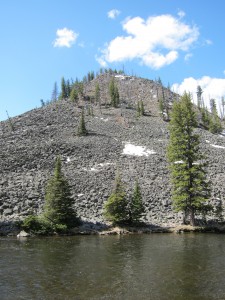 West Yellowstone, Montana is a cute little town, very stereotypical “old west” looking. It was established in 1908 after the Union Pacific railroad built a terminus there. The town’s sole purpose was to be a gateway to Yellowstone Park.
West Yellowstone, Montana is a cute little town, very stereotypical “old west” looking. It was established in 1908 after the Union Pacific railroad built a terminus there. The town’s sole purpose was to be a gateway to Yellowstone Park.
While there, we made a quick visit to the Yellowstone Historic Center, housed in the oldest building in town, the old Union-Pacific train depot.
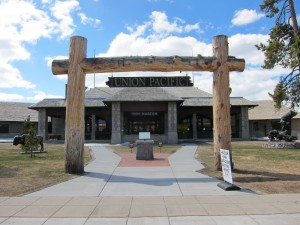 Once Eric’s business was taken care of, we headed back into Yellowstone Park. Here is a shot of buffalo grazing in the field.
Once Eric’s business was taken care of, we headed back into Yellowstone Park. Here is a shot of buffalo grazing in the field.
Unfortunately, because it was so early in the year, many of the attractions were closed. Most of the park was still buried in snow and the roads to access the snowier sites hadn’t yet been cleared. The animals tended to congregate in the thawed areas, so even much of the thawed areas were closed off to humans — partly to let the animals live in peace, partly to keep people safe from potentially aggressive animals (especially hungry bears that have just woken up from hibernation). The Fountain Paint Pot Nature Trail in the Lower Geyser Basin was open, another half-mile walking loop that passed by many unique geological sites:
1. The Celestine Pool, which seems to be just a regular hot spring, but with boiling water. In the second picture, you can clearly see the “bacteria mat,” or the colorful bacteria that live in the warm muddy water around the spring. In addition to interesting colors, the bacteria make the texture of the mud weird, too. The ground looks like it is parched and dry, not muddy.
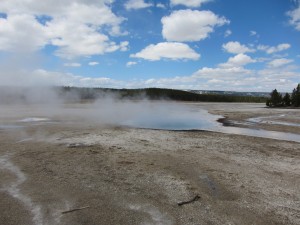
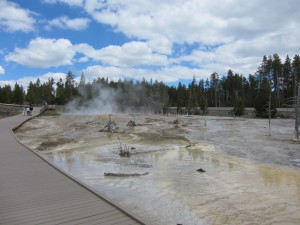 2. We didn’t see a sign indicating the name of this one:
2. We didn’t see a sign indicating the name of this one:
 3. Fountain Paint Pots, which are basically bubbling mud pools. Volcanic rock, mineral, acid and living organisms combine with heat, gas and water to create a clay like mud. The color and consistency vary based on time of year. Being as it was early spring, the mud was thin from all the snow melt. Apparently, when the mud is thicker it is more interesting.
3. Fountain Paint Pots, which are basically bubbling mud pools. Volcanic rock, mineral, acid and living organisms combine with heat, gas and water to create a clay like mud. The color and consistency vary based on time of year. Being as it was early spring, the mud was thin from all the snow melt. Apparently, when the mud is thicker it is more interesting.
 4. Fumaroles, which are basically just vents that let the hot air out from under the Earth’s crust.
4. Fumaroles, which are basically just vents that let the hot air out from under the Earth’s crust.
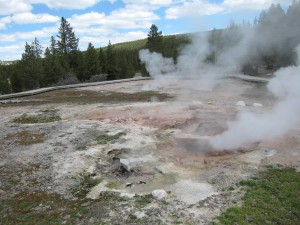 5. Red Spouter is technically a fumarole, but in the wet season it fills with water, making it appear like a small geyser. Red Spouter is a new attraction. It formed on August 17, 1959, after a 7.5 magnitude earthquake centered 25 miles away rocked the park. Prior to that, this was a grassy knoll.
5. Red Spouter is technically a fumarole, but in the wet season it fills with water, making it appear like a small geyser. Red Spouter is a new attraction. It formed on August 17, 1959, after a 7.5 magnitude earthquake centered 25 miles away rocked the park. Prior to that, this was a grassy knoll.
6. Leather Pool, which is only lukewarm and contains a brown bacteria.
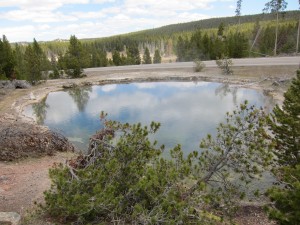 7. Clepsydra Geyser, which supposedly erupts constantly, but it didn’t erupt while we were there. However, since it was cold, we didn’t hang around very long waiting for an eruption, either.
7. Clepsydra Geyser, which supposedly erupts constantly, but it didn’t erupt while we were there. However, since it was cold, we didn’t hang around very long waiting for an eruption, either.
After we finished the nature trail, we went to see the Old Faithful Geyser, probably the biggest attraction in the park. Since this is already an extraordinarily long post, we’ll stop here for now. Over the next week or so, we’ll put up a couple more posts completing Friday, May 14, 2010 — Day 21, starting with Old Faithful.
This is Part 16 of the Passage Across America series. Read Part 15 here and Part 17 here.

